Denny Diericx’s Double Dive Series

Coach Denny Diericx started coaching at Geneseo High School (IL) in 1983, becoming the head coach in 1991. He remained there until 2004, returning to the staff in 2014. In between he spent three years as offensive coordinator at Beloit College followed by seven years at Rockton Hononegah HS as the offensive coordinator. Denny and I enjoy having lunch together at Primanti’s when we visit the National Wing-T Clinic and it was nice to finally catch one of his clinic talks.
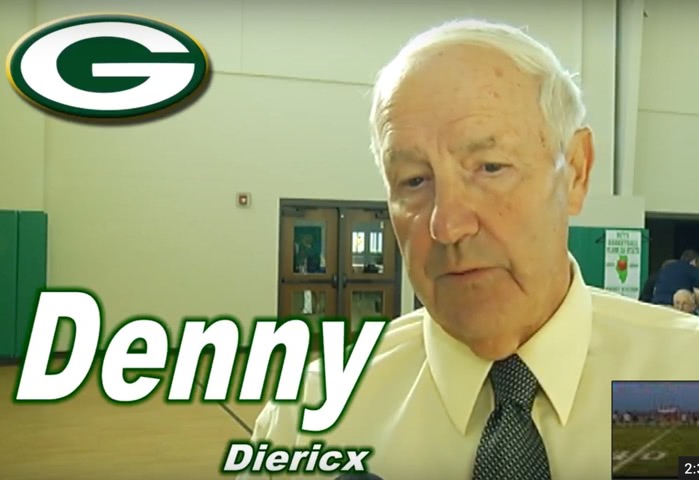
Denny’s talk was on his double dive series, which is not strictly a Wing-T series (I think it probably predates the Wing-T) but can easily be incorporated into any Wing-T scheme.
The Double Dive Philosophy
When I watch double dive film, I think “triple option” but from what I’ve learned most coaches don’t run this as an option series and instead rely on explicit calls on who will get the ball. Also, there’s no pitch relationship to worry about as it is the QB who attacks the flank.
Denny made these key points about the series:
- Provides deception and power, always attacking multiple parts of the line of scrimmage.
- Promotes a team concept as everyone must block, and backs must be able to fake and run hard on every play
- Creates mental toughness
- Frustrates opponents and limits possessions via ball control
- Forces opponents to defend sideline to sideline
Double Dive Basics
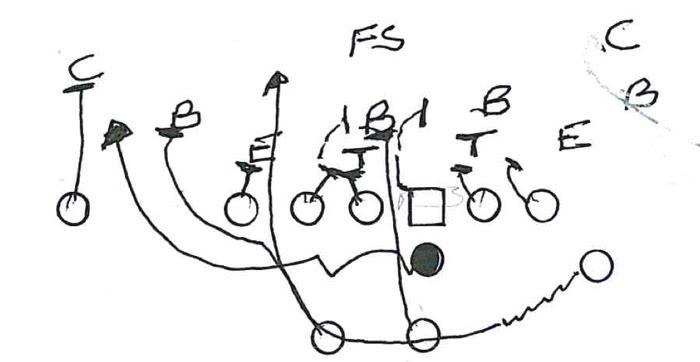
The image above shows the final progression in the double dive series, where the QB keeps the ball and attacks the flank. This is what he will call when run supports begins attacking the C gap to stop the 2nd back.
This video is a wishbone double dive, but can help get you acquainted with the look and flow as we dive (hah!) deeper.
Coach Diericx uses 2 foot splits and keeps his lineman as far off the line as legally possible. He will tighten to 18" when in a goal line situation. The FB is in a 3 point stance and he will split the SE out 10 to 12 yards.
The diagram above shows a flipped Wing-T backfield (dive back on the TE side, wing back opposite, SE over the TE) but you have a lot of flexibility in how to run the series. The motion of the wing into dive back position probably hints at the origins of this series in the straight-T offense.
1st Back (first play in series, FB dive)
This is the first play in the series and is an A-gap dive play to the fullback. He likes to establish this play early to make the linebackers very conscious of the A-gap threat.
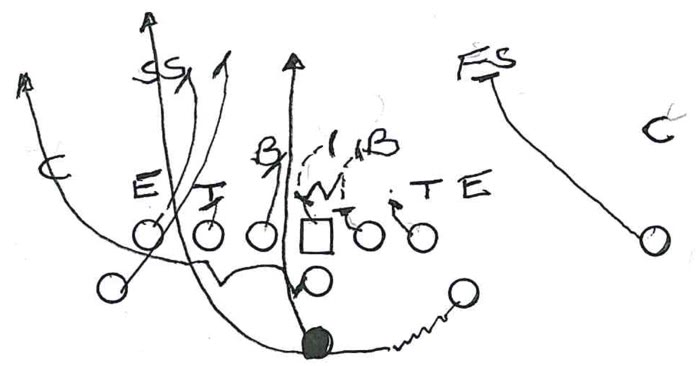
Here are the rules and teaching points:
- QB – He will open out almost to the mid-line, so in the above case (play side is to the left) he would pivot on his right foot and end up with his left foot at about the 7:00 position. He will seat the ball in his belt buckle. On his second step (with his right foot), he will step with the FB and ride with the ball in his belly, handing it off. There’s a rhythm to the QB footwork: “step back, step with, step out, step with.” He mesh fake with the back-side wingback, then carries out his fake to the flank.
- FB – Take first step with near foot to play-side aiming at inside heel of the play-side guard. His second step will be straight ahead while he receives the ball. He will square up his shoulders and run over the ball with inside arm up and thumb down. He should never cut back to the inside; read the 1st covered lineman from the center out. He must hit the hole quickly.
- Play-side HB – He should run through the C gap and block anything on level 1 (on the LOS), then look for a linebacker.
- Back-side HB – Coming from a wing position, he’ll take 3-step motion aiming for the outside heel of a dive back position. Then he flattens out and makes his aim point the inside foot of the TE. He should square up his shoulders and complete his mesh fake and run through C gap.
- TE – Gap-On-Backer
- PST – Gap-On-Backer
- PSG – Gap-On-Backer
- C – Fire-On-Backer
- BSG – Fire-On-Backer (cutoff play-side gap to back-side LB)
- BST – Fire-On-Backer (cutoff play-side gap to back-side LB)
- SE – Cutoff down-field
About “Fire-On-Backer”
When executing a “Fire” block a lineman takes a fire step with his playside foot, strikes with his head to the playside and uses the shoulder away from the direction of the block. For example a “Fire” block to the right would be with the left shoulder. This block is finished by driving the outside (right) hand into the outside number of the defender and bench-pressing with the outside (right) arm. He should also swing his tail and attempt to finish the defender back to the left
When a lineman has the rule “Fire-On-Backer” then his assignments is to “Fire” block the man on him or climb to the linebacker level if there is no man on him. Additionally, if two linemen lined up adjacent to each other both have the assignment “Fire-On-Backer” then we allow them to interpret their rule to “Scoop” block their area. When they scoop block, the covered lineman uses a “Fire” technique and the uncovered lineman uses a “Reach” technique, which starts with a flat 90-degree step. If the defender stays on the covered lineman then he executes a “Fire” block on him and the uncovered lineman climbs to the linebacker. However, if the defender slants to the inside then the covered lineman bench-presses him into the uncovered lineman and climbs to the linebacker. The uncovered lineman then executes a “Fire” block technique on the slanting defender.
2nd Back (second play in series, HB off-tackle)
The next play in the series is the true “double dive” play where the 2nd back gets the ball off-tackle.
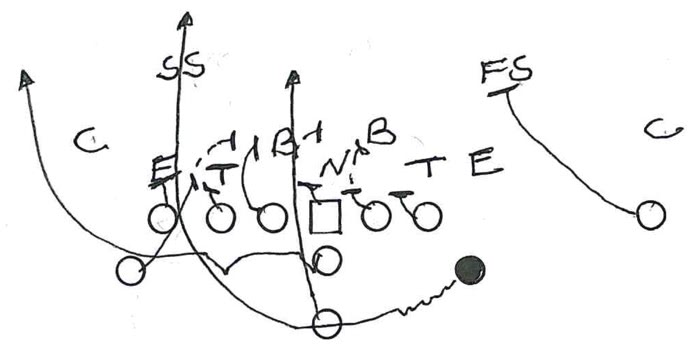
Here are the rules and teaching points:
- QB – Same as the 1st back rules, but will mesh fake with FB then give the ball to the BSHB.
- FB – Fake the 1st back dive play, then block first threat at 1st level.
- PSHB – Same as 1st back rule.
- BSHB – Coming from a wing position, he’ll take 3-step motion aiming for the outside heel of a dive back position. Then he flattens out and makes his aim point the inside foot of the TE. He should square up his shoulders race the QB to the hole. Never slow down, focus only on the hole and not the QB. Look for green grass to the boundary, and follow the PSHB.
- TE – 2nd “L.O.G.” (lineman outside the guard). Note – they do not treat a 3-tech DL (outside shade of the G) as “outside the guard”.
- PST – 1st L.O.G.
- PSG – Gap-On-Backer
- C – Fire-On-Backer (cutoff play-side gap to back-side LB)
- BSG – Fire-On-Backer (cutoff play-side gap to back-side LB)
- BST – Fire-On-Backer (cutoff play-side gap to back-side LB)
- SE – Release inside and go to cutoff
2nd Back Variations
There are quite a few variations that Coach Diericx will use. For example, with 5- and 9-tech on the playside he will call a cross block:
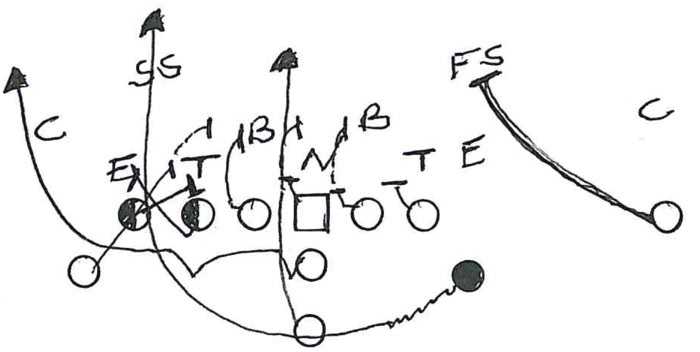
Influence - run TE around DE stud, go to corner, have HB kick out DE (he should be influenced by release).
Bullet - vs shaded N play side, the FB must help the center
Double Inside - double a 3-tech stud with PST and PSG. TE owns DE, HB owns strong-side backer.
QB Keeper
Here’s an example of the blocking vs. a 3–3 stack:
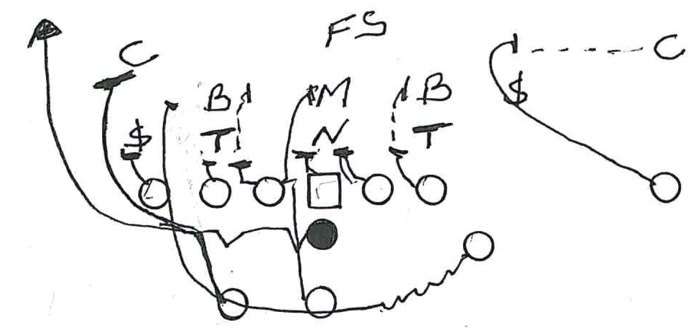
- QB – fake 1st back and 2nd back with good patient ride. Tuck ball away and run for width to 1st down sticks. Be patient and don’t rush fakes.
- FB – same as 2nd back.
- PSHB – reach first defender to show inside of TE block, Make block look like 2nd man
- BSHB – 3 step motion ad fake 2nd man through. “Rock the baby” with a convincing fake. You must get tackled or continued to safety.
- TE – Gap-On-Reach
- PST – Gap-On-Backer
- PSG – Gap-On-Backer
- C – Fire-On-Backer (cutoff play-side gap to back-side LB)
- BSG – Fire-On-Backer (cutoff play-side gap to back-side LB)
- BST – Fire-On-Backer (cutoff play-side gap to back-side LB)
- SE – He likes to run “SE over TE” when running QB keeper to pull the corner out. Split him wide and you can run a stalk-to-slant technique (if he presses, run him out on a slant, if not, stalk him).
Boot Pass
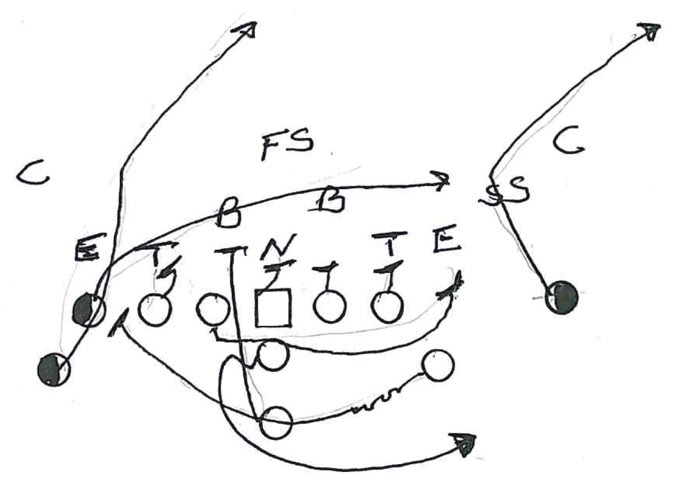
- QB – Open step and fake to FB on 1st man through, ride FB on 2nd step. On his 3rd step rub shoulders with BSHB, boot away at 5–6 yards depth with run or pass option. Feel block of pulling BSG or center.
- FB – Fake dive, fill for pulling lineman.
- PSHB – Fake double dive, block first to show outside of BST
- BSHB – Release through C gap and run skinny post
- TE – Crossing route
- PST – Gap-On-Area
- PSG – Gap-On-Area
- C – Covered: Block on. Uncovered: pull and log 1st to show outside PST
- BSG – Covered: Block on. Uncovered: pull and log 1st to show outside PST
- BST – Gap-On-Area
- SE – Angle flag route
Notes on Practicing
- They will use a hose (adjustable split marker) to work on backfield position and timing. Coach stands down LOS by hose, looking at exchanges
- He wants the exchange to be at the LOS or, even better, on the defensive side of the line. You can’t be 2 yards deep with the 2nd back!
- He will also run a full backfield with 2 hoses, facing each other for more reps